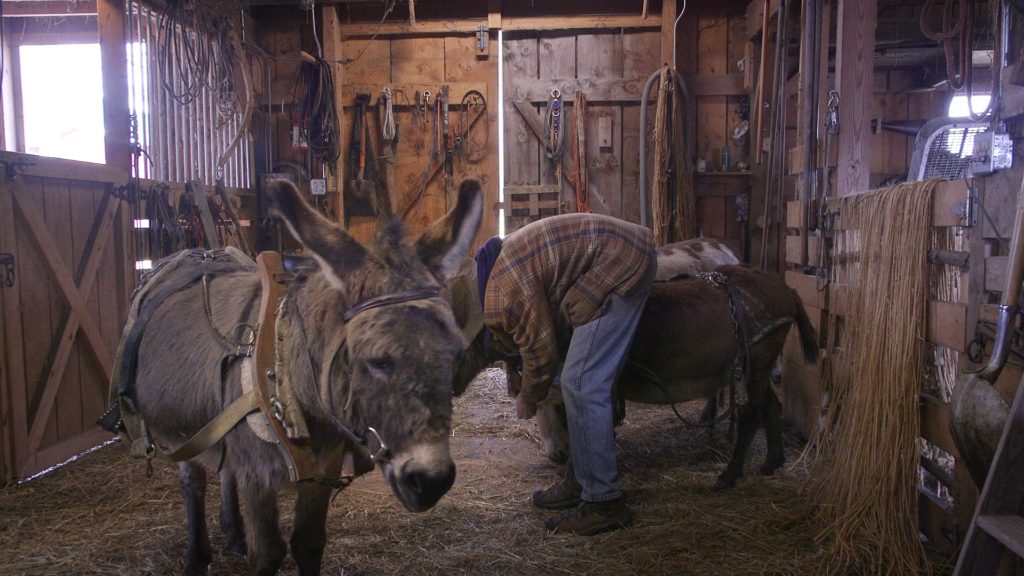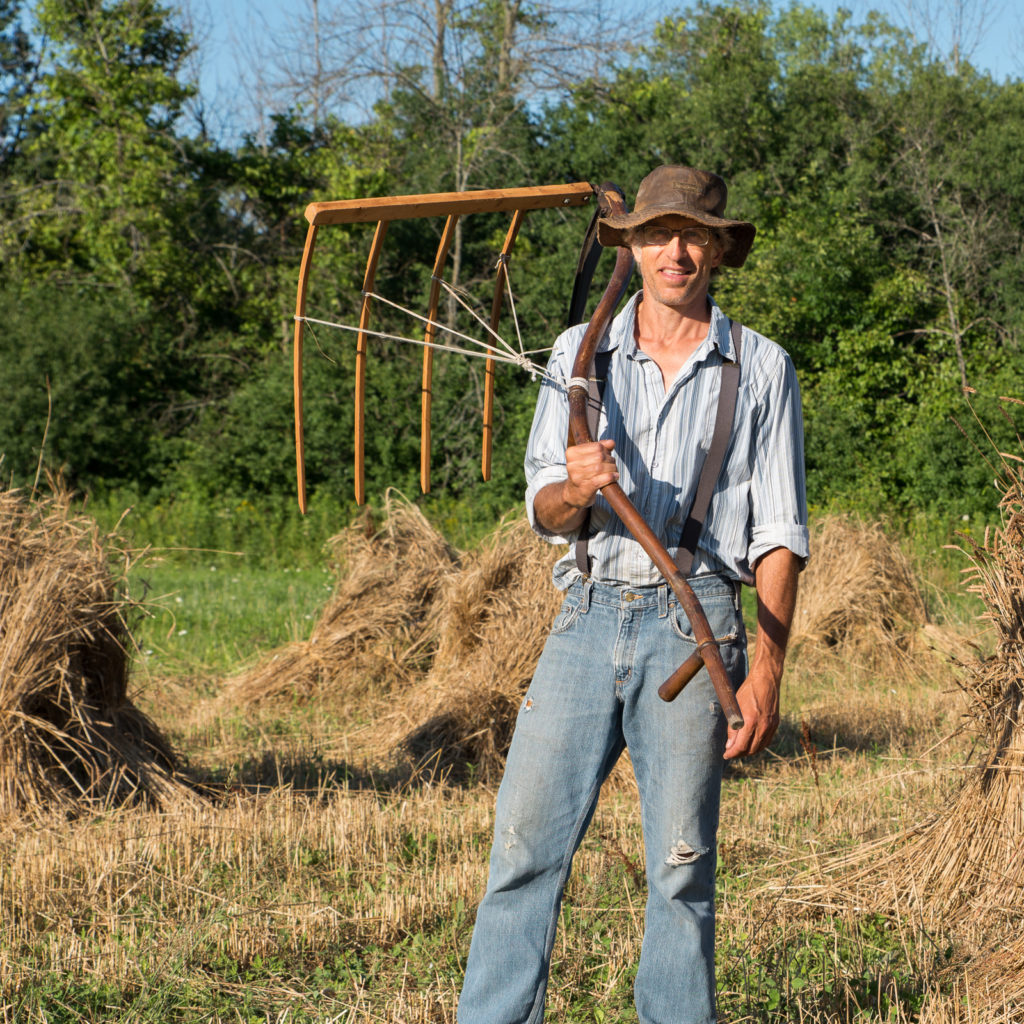This post was last updated on July 13th, 2022 at 09:49 am
Charlie Tennessen enjoys a good pizza. But what’s more, he enjoys the story behind the ingredients in that pizza.
It’s a big reason why he grows his own wheat on his homestead in Southeast Wisconsin, called Anarchy Acres. Tennessen doesn’t treat wheat as a commodity but as an experience.
“Every wheat that I grow, everything you see on my website, was once a hand-planted seed on my homestead that the donkeys and I grew. The seeds that I have are so rare that you can’t go buy them in quantity anywhere. Most of the seed I want are gone completely,” he explained during a recent interview with Frugalmatic.
That’s right—Tennessen uses donkeys to pull a plow that Tennessen built himself. And his wheat is then ground with a mill that Tennessen also built. So when you buy a bag of Tennessen’s flour, you’re getting much more than flour. You’re buying a product with a story.
It’s also a product designed to respect the environment.
“I like to look at my farm and think it could last 10,000 years. The donkeys largely live off the grass that grows here on the farm. The fertilizer for my garden comes from the compost and manure that the donkeys create. And it’s all fueled by the sun and the rain. And we’re not depleting our soil the way a lot of modern farms do,” he said.
As a bonus, his farm setup ensures Tennessen stays physically active. “It really is a personal way to make myself behave better and be a healthier person,” he explained.
To be clear, Tennessen doesn’t reject modern technology. In fact, he ran a separate internet business for years while maintaining his farm. Just recently, he shifted to making his farm a full-time occupation. “I’m trying to make the stone-ground flour business my last business. I’ve had a bunch of businesses in my life, and I want this to be the last one.”
Read more excerpts from the interview with Charlie Tennessen below:
Frugalmatic: What aspect of farming do you enjoy the most?
Charlie Tennessen: I like the challenge. I like how it puts me in a situation where I have to behave healthy and responsibly.
If you put me in a room full of Coca-Cola and candy bars, I’d just have the Coca-Colas and candy bars. But if I put myself on a farm, I have to exercise every day as part of farming. My garden is 600 feet away from where I am right now in my office. I had to walk there several times today, carrying things back and forth.
Once you grow something, you get attached to it, and so you have to eat it. It really is a personal way to make myself behave better and be a healthier person.
I love the cycle of seasons. I like things that change over time and like to see how things turn out. It doesn’t always work out. But the longer you live, you realize that when things don’t work out, you usually learn more than if things do work out. Probably the thing I love most about being alive is learning.
F: Flour was in short supply during the COVID-19 pandemic lockdowns. Did people develop a new appreciation for the ingredient and discover your flours?
CT: We definitely had a rush right at lockdown. I did about six months’ worth of business in about six weeks. So we sold out right away. It’s back to normal right now. I did run out about eight months ago, but now I’m back in stock. We just had our harvest.
The customers are all over the place. We have an epidemic of wheat allergies and wheat sensitivities in our society. There’s good evidence, certainly a lot of anecdotal evidence, that older varieties help people in those situations.
My wheat is different from several different perspectives. First of all, it’s fresh. It doesn’t sit around too long. It’s stone ground and has most of the germ and bran still in it, as opposed to white flour, which has it all stripped out.
It’s also grown in fields that don’t have any artificial accelerants like fertilizers. That changes the way it grows, changes the protein makeup.
For those reasons, that’s probably why people who have trouble having a hot dog bun at the ballpark can eat just fine bread made from my flour.
F: I watched the preview on your website for the documentary you created, “25 Weeks: A Wisconsin Harvest.” I was struck by something you said, “A good pizza doesn’t have much to do with how you prepare it or bake it. The magic is where the ingredients came from and how they got there.” What do you mean by that?
CT: When I look at a plate, I want to go way back there. I see something on the plate and wonder, where did that crop come from? That corn on the plate, what variety of corn is it? What field did it come from? What part of the world did it come from? Who grew it and why?
The pizza is just the culmination. The little bits and fiddling we do in the kitchen are interesting and fine. And, of course, you can make a career out of that. But I think about how it grew, where it was grown, and why.
I mean, we didn’t have corn 20,000 years ago. That’s kind of new. We didn’t have wheat 100,000 years ago. So why do we have wheat now? Well, people noticed this grass, and the way they interacted with that grass evolved over time.
It’s not like someone 20,000 years ago said I want to have a loaf of bread today or pizza. The way they existed with this wild grass over time turned it into red wheat and, eventually, 10,000 years later, Charlie can have a pizza.
I find those relationships, if I can see that on the plate, just so beautiful. I think that’s the most important part. It was really cool how that person tossed that dough in the kitchen and all that flair. But I like to look a little deeper and see where it really came from.
More reads: Whole foods are the stars of the frugalmatic diet
F: Would you talk a little bit about your relationship with technology? On the one hand, you practice pre-industrial revolution farming techniques to create your special line of flours. On the other hand, you have a website and use it to sell your products. Of course, we’re doing this interview over Zoom. How do you decide which types of technology to allow into your life?
CT: I’m not unique in that there a lot of folks doing what we do. We call it “appropriate technology.” Everything I do involves technology. It might not be high technology, and I find a real beauty in all technology. I’ve gone very deep into computer programming and electronics, and I built the harness that my donkeys used to pull the plow. And I built most of the parts on that plow. So those are all things that are technology, and farming is nothing but technology.

Starting about 200 years ago, there was an explosion in technology. Two hundred years ago, I think the world population was around 500 million, and we’re up to 7 to 8 billion now, and that’s all because of farming technology. Without those changes, we couldn’t possibly support the world population.
You need farming for everything you got. It’s all behind everything …
I don’t use a rotary tiller on my farm. One, it’s an aesthetic choice. Two, it’s just not appropriate. I don’t need that much horsepower on a half-acre garden…
I’m not afraid of high technology, but I think it has its time and its place.

